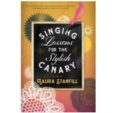Singing Lessons for the Stylish Canary is a beautifully crafted novel that blends elements of fairy tales, magical realism, and historical fiction. Set mostly in a small town in nineteenth-century France, it follows the family of Henri Blanchard, who craft a unique kind of musical device. The writing is lyrical and imaginative, bringing a fully formed world to life with vivid descriptions and characters, and the plot unspools as smoothly as thread from a bobbin.

A serinette
The story starts with Henri’s grandfather, who makes serinettes, devices in which a small bellows is cranked to force air through a series of pipes, like a miniature pipe organ in the form of a music box. (Here’s a video of a serinette in action.) Serinettes are used by wealthy women to teach canaries melodies to sing for competitions, a fashionable pastime.
Henri’s father, Georges, becomes known as “The Sun-Bringer” after an incident from his childhood. Back then, the village of Mireville (based on the real-life French town of Mirecourt, where the inhabitants did indeed make serinettes) was a dreary, rainy place. When Georges’ mother, Cérine, took him out one day, the clouds parted, a ray of light shone down on them both, and Mireville became a sunny place. For the rest of his life, Georges is associated with this miraculous occurrence, while Cérine (and later, Georges’ wife) wonder whether Cérine was in fact the bringer of the sun. Shouldn’t a woman deserve some credit?
Georges comes of age and travels to New York to visit an important and very wealthy client of the serinette workshop, Delia Dumphries Stanton, who is having difficulties in her marriage. Events ensue.
Eventually, the story comes around to Henri and his life in Mireville with his best friend, Aimée, organizer of the delightfully named Shadow Council of Apprentice Lacemakers, whose members help Henri translate a cache of letters that his father has received from Delia. The letters reveal information that changes the way that Henri sees himself. Henri also discovers a power that makes the “The Sun-Bringer” look like a minor player. The magical realism and fantasy elements are seamlessly integrated into the narrative, making the story feel believable and enchanting. Eventually darker, fully realistic elements come to the fore.
In an interview, Stanfill says, “In putting whimsy on the page…I still wanted my characters to experience big events so they’d feel real and multifaceted to readers. In other words, I didn’t want to evoke the playfulness without deeper meaning, undercurrents of grief and despair, actual life stakes. Maybe, to [use a] clothing metaphor, this braid of major themes and fairy-tale sensibilities is like a fancy gown pinned to a clothesline. It moves in the wind. It’s a curiosity—beautiful, unexpected, but hopefully it also makes us wonder. Has this garment been forgotten or abandoned? What’s the story?”
Stanfill explores the pull of tradition set against the desire to make one’s own way. “Everyone in Mireville knew each other’s great-grandfather’s middle names.” Characters embark on attempts at self-determination, seeking to break away from the history and remoteness they were born into.
Stanfill’s use of language is precise and delicate, capturing the sights, sounds, and emotions of the world she has created. When Henri sees a canary aviary for the first time, the description of his experience is exquisitely lyrical: “Inside, peppery dots of color flitted around in the air, as if the layers of rainbows had peeled apart from each other.”
There are many things in addition to engaging writing that go into producing a quality novel. Laura Stanfill is lucky to partner with folks who clearly know how to craft a beautiful book. Lanternfish Press deserves a mention for Singing Lessons’ lovely cover and its distinctive and elegant typography and design. The novel hits on all cylinders.
This is a captivating and memorable book, one worth reading. The attention to detail, imaginative writing, and engaging characters make it a standout. Whether you are a fan of fairy tales, enjoy a touch of magical realism, or just like good storytelling, this book is sure to delight and entertain. Stanfill says it took fifteen years to write. It was worth the wait.
Would My Pick be Your Pick?
If you're interested in ________, the answer may be "Yes":■ Novels with a bit of magical realism
■ Stories about family traditions through generations
■ Novels set in the nineteenth century
■ Stories that touch on gender inequality
■ France

